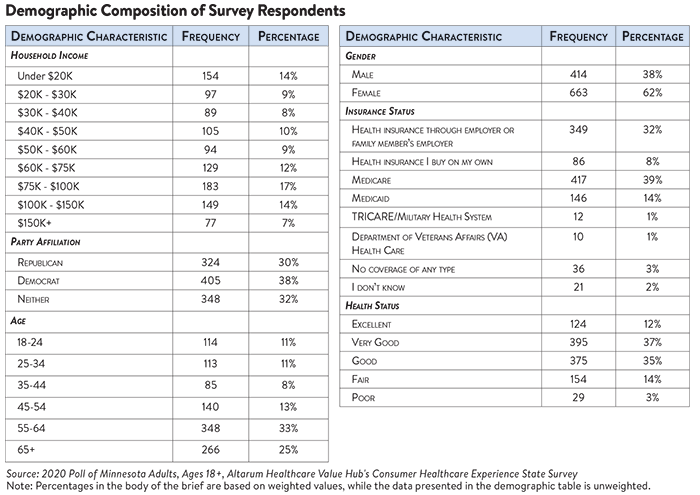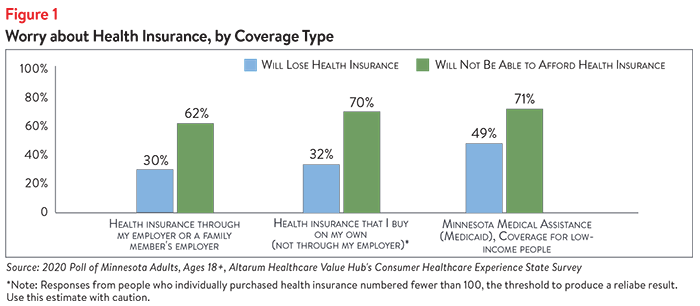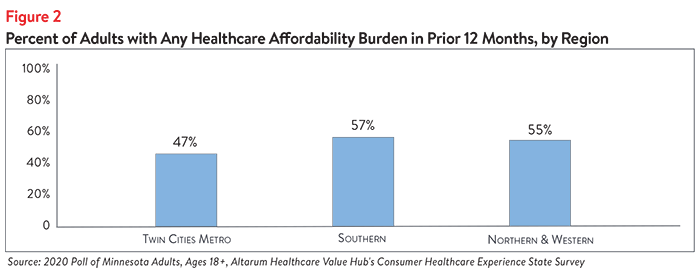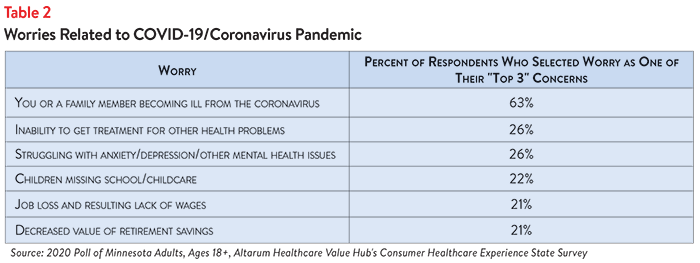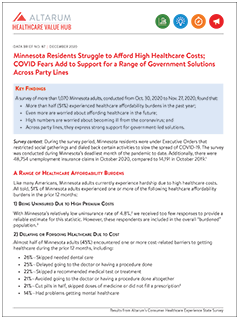Minnesota Residents Struggle to Afford High Healthcare Costs; COVID Fears Add to Support for a Range of Government Solutions Across Party Lines
Key FindingsA survey of more than 1,070 Minnesota adults, conducted from Oct. 30, 2020 to Nov. 27, 2020, found that:
|
Survey context: During the survey period, Minnesota residents were under Executive Orders that restricted social gatherings and dialed back certain activities to slow the spread of COVID-19. The survey was conducted during Minnesota’s deadliest month of the pandemic to date. Additionally, there were 48,754 unemployment insurance claims in October 2020, compared to 14,191 in October 2019.1
A Range of Healthcare Affordability Burdens
Like many Americans, Minnesota adults currently experience hardship due to high healthcare costs. All told, 51% of Minnesota adults experienced one or more of the following healthcare affordability burdens in the prior 12 months:
1) Being Uninsured Due to High Premium Costs
With Minnesota’s relatively low uninsurance rate of 4.8%,2 we received too few responses to provide a reliable estimate for this statistic. However, these respondents are included in the overall “burdened” population.3
2) Delaying or Forgoing Healthcare Due to Cost
Almost half of Minnesota adults (45%) encountered one or more cost-related barriers to getting healthcare during the prior 12 months, including:
- 26%—Skipped needed dental care
- 25%—Delayed going to the doctor or having a procedure done
- 22%—Skipped a recommended medical test or treatment
- 21%—Avoided going to the doctor or having a procedure done altogether
- 21%—Cut pills in half, skipped doses of medicine or did not fill a prescription4
- 14%—Had problems getting mental healthcare
Moreover, cost was by far the most frequently cited reason for not getting needed medical care, exceeding a host of other barriers like transportation, difficulty getting an appointment and lack of childcare.
Of the various types of medical bills, the ones most frequently associated with an affordability barrier were doctor bills, dental bills and prescription drugs, likely reflecting the frequency with which Minnesota adults seek these services or, in the case of dental, perhaps lower rates of coverage for these services.
3) Struggling to Pay Medical Bills
Other times, Minnesota adults got the care they needed but struggled to pay the resulting bill. More than a quarter of Minnesota adults (27%) experienced one or more of these struggles to pay their medical bills:
- 10%—Contacted by a collection agency
- 10%—Unable to pay for basic necessities like food, heat or housing
- 9%—Used up all or most of their savings
- 7%—Placed on a long-term payment plan
- 7%—Racked up large amounts of credit card debt
- 5%—Borrowed money, got a loan or another mortgage on their home
High Levels of Worry About Affording Healthcare in the Future
Minnesota adults also exhibit high levels of worry about affording healthcare in the future. Overall, 3 in 4 adults (76%) reported being “worried” or “very worried” about affording some aspect of healthcare in the future, including:
- 65%—Nursing home or caregiving services
- 60%—Medical costs when elderly
- 55%—Cost of a serious illness or accident
In addition, 60% of respondents are “worried” or “very worried” about not being able to afford health insurance in the future. These concerns vary by type of insurance coverage, with those on Medicaid being most concerned about losing their coverage. Concerns about affording health insurance exceeded fears about losing coverage across all insurance types (see Figure 1).
Regional Differences in Healthcare Affordability Burdens
The survey also revealed regional differences in how Minnesota adults experience healthcare affordability burdens.
Affordability burdens affect families in every region of Minnesota, with 57% of residents in the Southern region facing healthcare affordability burdens—the highest in the state (see Figure 2). Additionally, a staggering 51% of Southern region adults reported skipping a recommended medical test or treatment due to cost, compared to 41% of Twin Cities Metro area residents and 49% of those who live in the Northern & Western region.
Worries about affording healthcare in the future are also high throughout the state. Though residents in the Southern region reported the highest levels of worry, the vast majority of adults in the Twin Cities Metro area and Northern & Western regions report being worried, as well (see Table 1).
COVID Worries
In addition to affordability worries, Minnesota adults were asked about their top worries related to the COVID crisis.5 When asked about “affording treatment of coronavirus/COVID-19 if you need it,” 57% of respondents were “worried” or “very worried.”
Separately, out of twelve possible responses, respondents were asked to pick the top three things they were most worried about (see Table 2). “Becoming ill from the virus” was not only the most frequently selected by respondents, but it exceeded other worries by a wide margin. Sixty-three percent of respondents selected “Becoming ill from the virus” as one of their top three concerns, while 26% of respondents selected the next most common worry, “Inability to get treatment for other health problems,” as a top three concern.
In smaller numbers, Minnesota adults worried about many other issues, including: affording treatment if they or someone in their family gets the virus (20%), safety at work—not getting the virus at work (18%), job loss and resulting loss of health coverage (16%), unavailability of COVID treatment if they or a family member gets sick (16%) and something else (16%).
Dissatisfaction with the Health System and Support for Change
In light of these healthcare affordability and COVID concerns, it is not surprising that Minnesota adults were extremely dissatisfied with the health system. Statewide:
- Just 34% agreed or strongly agreed that “we have a great healthcare system in the U.S.,”
- While 65% agreed or strongly agreed that “the system needs to change.”
The survey asked about both personal and governmental actions to address health system problems.
Personal Actions
Minnesota adults do see a role for themselves in addressing healthcare affordability. When asked to rank the three personal actions that would be most effective in addressing the affordability of healthcare (out of ten options), top vote getters were:
- 67%—Take better care of my personal health
- 37%—Write or call my STATE representative asking them to take action
- 36%—Research treatments myself, before going to the doctor
- 32%—Write or call my FEDERAL representative asking them to take action
They also reported specific actions they have already taken, like researching the cost of a drug beforehand (49%), as well as action they should be taking—78% said they would switch from a brand to a less expensive generic drug if given a chance.
Government Actions
But far and away, Minnesota residents see government as the key stakeholder that needs to act to address health system problems. Moreover, addressing healthcare problems was a higher priority than other issues that Minnesota residents want their elected representatives to work on.
At the beginning of the survey, respondents were asked what issues the government should address in the upcoming year. The top vote getters were:
- 69%—Healthcare
- 63%—Economy/Joblessness
- 39%—Taxes
The economic woes brought on by the COVID crisis likely contributed to “Economy/Joblessness” as a primary concern, but addressing healthcare remained the top issue that Minnesota adults want their elected representatives to work on.
When asked about the top three healthcare priorities the government should work on, top vote getters were:
- 53%—Address high healthcare costs, including prescription drugs6
- 42%—Preserve consumer protections, like: you can’t be denied coverage or charged more if you have a pre-existing medical condition
- 32%—Get health insurance to those who cannot afford coverage
Of more than 20 options, Minnesota adults believe the reason for high healthcare costs is unfair prices charged by powerful industry stakeholders:
- 70%—Drug companies charging too much money
- 61%—Insurance companies charging too much money
- 56%—Hospitals charging too much money
When it comes to tackling costs, respondents endorsed a number of strategies, including:
- 91%—Expand health insurance options so that everyone can afford quality coverage
- 91%—Show what a fair price would be for specific procedures
- 90%—Make it easy to switch insurers if a health plan drops your doctor
- 89%—Require insurers to provide up-front cost estimates to consumers
- 88%—Ensure the cost of widely needed vaccines are affordable for all
- 86%—Require hospitals and doctors to provide up-front cost estimates to consumers
- 85%—Set standard payments to hospitals for specific procedures
For the most part, support for policy solutions was high and consistent across regions. For example, 91% of adults in all three regions supported expanding health insurance options so that everyone can afford quality coverage. However, while 90% of Southern region adults endorsed setting standard payment to hospitals for specific procedures, 84% of Twin Cities Metro region adults and 85% of Western and Northern region adults supported the policy—indicating small regional variation in support for certain policy strategies.
Support for Action Across Party Lines
What is remarkable about the findings is high support for change regardless of respondents’ political affiliation (see Table 3).
Policies to Address COVID Concerns
In addition to residents’ views on the policies and approaches above, new questions were asked about support for and against policies related to the COVID crisis. Out of eleven possible responses, respondents were asked to pick the top three policies that would help address COVID-related problems. There was significant diversity in the policies supported, with the highest percentages of respondents selecting “Additional Federal stimulus” and “More financial help for small businesses” as a top 3 priority. The next most supported policies received nearly equal levels of support (see Table 4). “More financial help for large businesses” received the least support, as it was a priority for only a small percentage of respondents.

When respondents were asked about which policies they did NOT support, 33% indicated that they did not support “More financial help for large businesses.” Trailing behind that (with 27% of respondents selecting) was “Universal health coverage for all,” although a higher percentage of respondents indicated support. In this area, there was a lack of agreement across party lines, with Republicans far more likely to NOT support “Universal health coverage for all” as a means to address COVID-19 concerns, compared to Democrats and those not affiliated with either party (see Table 5). It is important to note, however, that when asked generically about “Expanding health insurance options so that everyone can afford quality coverage,” 91% of respondents agreed or strongly agreed with this policy as a means of improving affordability, with high levels of support across party lines (see Table 3).
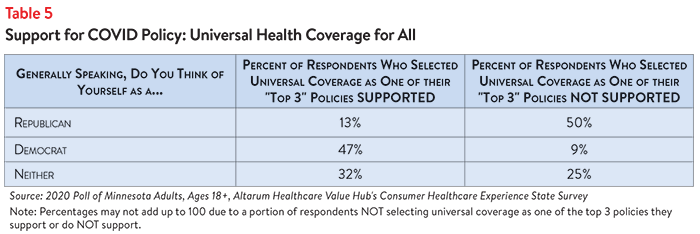
When asked about the policies they did NOT support, respondents were given the option of selecting “I support all of the policies listed.” Thirty-five percent of respondents selected this option.
The high burden of healthcare affordability, along with high levels of support for change, suggest that elected leaders and other stakeholders need to make addressing this consumer burden a top priority. Moreover, the current COVID crisis is leading state residents to take a hard look at how well health and public health systems are working for them, with strong support for a wide variety of actions. Annual surveys can help assess whether or not progress is being made.
Comparing 2020 Results to the 2019 CHES Survey
We caution readers against drawing strong conclusions about changes observed between the 2019 and 2020 CHES surveys. While the findings from the two surveys are remarkably consistent, small differences in the weighting approach and in the instrument itself (most significantly the addition of the COVID questions) indicate that direct comparisons should not be made. For more information on the Minnesota state surveys, go to www.healthcarevaluehub.org/minnesota-state-survey.
Notes
1. Employment and Economic Development, Unemployment Insurance Statistics Monthly Claims Visualization Tool, 2020.
2. Kaiser Family Foundation, Health Insurance Coverage of the Total Population, 2019.
3. In the 2019 CHES survey, 43% of uninsured adults in Minnesota cited “too expensive” as the major reason for not having coverage, far exceeding reasons like “don’t need it,” “don’t know how to get it” and other reasons. For more information, see: https://healthcarevaluehub.org/advocate-resources/publications/minnesota-residents-struggle-afford-high-healthcare-costs-support-range-government-solutions-across-party-lines
4. Of the current 45% of Minnesota adults who encountered one or more cost-related barriers to getting healthcare during the prior 12 months, 15% did not fill a prescription, while 16% cut pills in half or skipped doses of medicine due to cost.
5. COVID-19 is the disease caused by the Coronavirus, which was characterized as a pandemic by the World Health Organization on March 11, 2020. For a comparison of how respondents from Connecticut, Kentucky, Mississippi and New Jersey answered our COVID questions, please see Healthcare Value Hub, How COVID Has Shaped Residents’ Broader Attitudes Towards the Health System, Data Brief No. 86.
6. To learn more about Minnesota adults’ worries and support for solutions to address high prescription drug costs, see Healthcare Value Hub, Minnesota Residents Worried about High Drug Costs; Support a Range of Government Solutions, Data Brief No. 88.
Methodology
Altarum’s Consumer Healthcare Experience State Survey (CHESS) is designed to elicit respondents’ unbiased views on a wide range of health system issues, including confidence using the health system, financial burden and views on fixes that might be needed.
The survey used a web panel from Dynata with a demographically balanced sample of approximately 1,000 respondents who live in Minnesota. The survey was conducted only in English and Spanish and was restricted to adults ages 18 and older. Respondents who finished the survey in less than half the median time were excluded from the final sample, leaving 1,077 cases for analysis. After those exclusions, the demographic composition of respondents was as follows, although not all demographic information has complete response rates:
